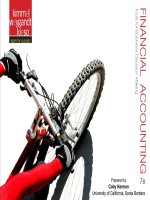Practical financial managment 7e LASHER chapter 3
Bạn đang xem bản rút gọn của tài liệu. Xem và tải ngay bản đầy đủ của tài liệu tại đây (512.33 KB, 50 trang )
Chapter 3 - Cash Flows And Financial Analysis
Users of Financial Information
Investors
– Make judgments about the firm's securities
– Financial Analysts report to investment community
Vendors
– Sell to the firm on credit
Management
– Highlight areas in which attention will improve performance
2
Sources of Financial Information
Annual Report
Management's report card to
stockholders on own performance
–
–
The primary source of financial
information
–
Required of publicly traded
companies
–
–
Must be audited
GAAP
Other Sources
Reports from brokerage
firms and advisory services
–
–
–
Value Line
Credit reports
3
Orientation of Financial Analysts
Critical and investigative
Looking for current or potential problems
Looking for the physical reasons behind financial results
4
Statement of Cash Flows
Businesses run on cash, not accounting profits
It is possible for a business to go out of business while making a
profit
Statement of Cash Flows
–
–
Reports inflows and outflows of money
Developed from the income statement and balance sheet
5
Building the Statement of Cash
Flows – Basic Approach
Build a Statement of Cash Flows from two balance sheets and an income
statement
Analyze where money has come from and gone to
Begin with some personal examples
6
Table 3-1 Cash Flow Rules
Asset Increase = Use
Liability Increase = Source
Asset Decrease = Source
Liability Decrease = Use
7
Buying a Car on Credit
Joe Jones and His New Car
8
Buying and Selling Cars Sally Smith and Her Two Cars
9
Buying and Selling Cars Sally Smith and Her Two Cars
10
Business Cash Flows
Three sources of cash flows:
Operating Activities – day-to-day activities
Investing Activities – firm buys or sells ( or invests in) fixed assets that enable it to do
business.
Financing Activities – borrow money, pay off loans, sell stock, pay dividends.
12
Figure 3.2 BUSINESS CASH FLOWS
13
Example 3-1 Business Cash Flows
Additional Information
Belfry also sold new stock during the year receiving a total of
$800 and paid its shareholders dividends of $500.
Operating Activities
Net Income
$ 1,000
Depreciation
500
Net Change in Current Accts
(600)
Cash from Operating Activities
$
900
Detail of Changes in Current Accounts
Account
Receivables
Begin
End
$3,000 $2,900
Inventory
2,000
Payables
1,500
2,100
Accruals
500
400
(600)
3,200
Source/(Use)
$ 100
(1,200)
600
(100)
$
Investing Activities
Purchase of Fixed Assets
$(2,000)
Use Change in Gross Fixed Asset Account
Financing Activities
Increase in Long Term Debt
$ 1,200
Sale of Stock
800
Dividends Paid
(500)
Cash from Financing Activities
$ 1,500
Free Cash Flows (FCF)
Used to estimate whether a company will provide or require cash in
future
Cash generated by operations that’s available for distribution to
investors.
If negative, owners must borrow or sell equity just to keep going
as before
21
Calculating Free Cash Flow
NOPAT is net operating profit.
T = tax rate
NOPAT = EBIT – (T)(EBIT) = EBIT (1 – T)
Note: If there is no debt, NOPAT equals net income
22
Calculating Free Cash Flow
Depreciation is subtracted from revenue when calculating EBIT.
Depreciation is a noncash charge, so EBIT understates cash flow by at least
that amount.
Adding back depreciation gives a figure that’s closer to cash flow called
operating cash flow.
Operating Cash Flow = NOPAT + Depreciation
23
Calculating Free Cash Flow
Money available to investors can be written as:
FCF = Operating Cash Flow
– Increase in Gross Fixed Assets
– Increase in Current Accounts
24
Calculating Free Cash Flow to Equity (FCFE)
If a company is able to distribute cash to stockholders, then the equation becomes:
FCFE = Operating Cash Flow
– Increase in Gross Fixed Assets
– Increase in Current Accounts
– (1-T)Interest – Principal Reduction
25









